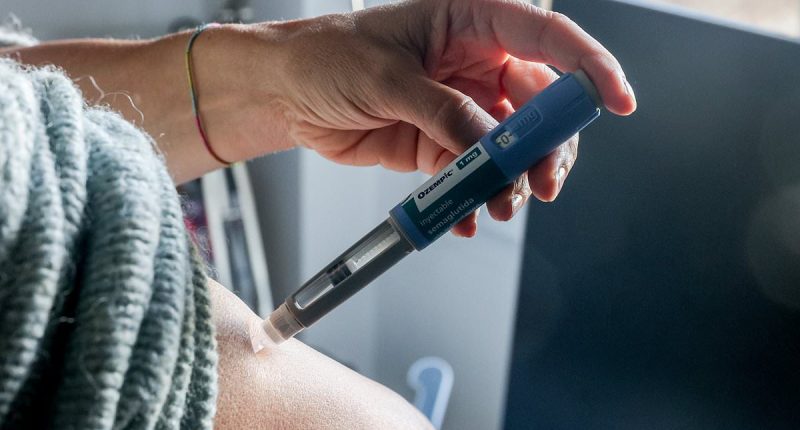Share this @internewscast.com
Ozempic has been linked to a potentially blinding condition that causes internal bleeding behind the eyes.
An Israeli study found patients taking Ozempic or similar weight-loss shots were twice as likely to suffer from a serious degenerative eye disease compared to those not on the medication.
The condition, neovascular age-related macular degeneration (nAMD), causes leaky blood vessels to grow behind the eye, which can spill fluid into the retina — leading to permanent damage and blindness.
Ozempic and similar medications work by mimicking the body’s naturally occurring GLP-1 hormone, which reduces hunger.
And while the exact link between weight-loss drugs and vision problems isn’t known, scientists believe they bind to GLP-1 receptors in the eye, triggering the growth of the blood vessels.
Although cases were rare, experts warned over the concerning signal in the data — saying that further research was needed.
It is at least the second eye condition to be linked to the drug, after scientists also found a potential link to non-arteritic anterior ischemic optic neuropathy (NAION) — a condition where the optic nerve is damaged, causing blindness.
And comes just days after the drug was linked to a higher risk of kidney cancer, although researchers said it lowers the risk of other forms of cancer.


After being resigned to being obese, Brad Roberts couldn’t believe it when he lost 24lbs in a month on weight loss drugs. However, in a shocking turn of events, the 44-year-old father-of-four and his wife Stacey are suing the doctor who prescribed him the weight loss drugs
About one in eight Americans have already tried a GLP-1 like Ozempic, surveys suggest, while around 15million — or 6 percent — are thought to be currently on the medications.
Age-related macular degeneration affects about 19million adults in the US, estimates suggest, with older adults being most commonly affected.
Of these, about 1.5million have the late stage form, with nAMD behind around 10 percent of these cases — according to the non-profit Bright Focus. It says that 90 percent of patients diagnosed with nAMD are considered legally blind.
In the condition, new, abnormal and fragile blood vessels grow on the macula — an area in the center of the eye behind central, high-resolution, color vision — and may then leak blood and fluid onto it, causing damage and loss of vision.
While it isn’t clear exactly what causes the condition, the American Academy of Ophthalmology suggests that it could be due to shifts in hormones in the eye sparking the growth of more blood vessels.
For the study, published in JAMA Opthalmology, scientists extracted data on 139,000 adults in Ontario, Canada, from the ICES database — which collects data on patients in the province from public sources.
All of the patients had type 2 diabetes, and they were 66 years old on average. Some 46 percent were female.
Around 46,000 were prescribed a weight loss drug like Ozempic for at least six months — while the rest took different diabetes drugs.
Over three years, researchers recorded 93 cases of nAMD in the weight loss drug group (or 0.2 percent of patients).
But in the group not using the drug, there were 88 cases (or 0.1 percent of patients).

Real Housewives of New Jersey star Dolores Catania admitted to using Ozempic to lose weight for the six weeks ahead of the RHNJ reunion. There is no evidence that she lost any vision due to the drug

Todd Engel pictured above with his wife Shelley. He has lost vision in both his eyes after taking the weight loss and type 2 diabetes medication Ozempic
The researchers said: ‘An explanation for the increasing risk with prolonged exposure is that the retina contains receptors for GLP-1, and [these] are known to increase the levels of CXCL12.’
The researchers said CXCL12 is a substance that attracts white blood cells, with this possibly causing the growth of new blood vessels.
Out of the patients, 97 percent were reported to be on a semaglutide — which includes semaglutide — while the rest were on lixisenatide — brand name Adlyxin.
Scientists started tracking the individuals between January 2020 and November 2023 for up to three years on average.
Ozempic’s maker Novo Nordisk is already facing several lawsuits from people who say that the drug robbed them of their sight — including Todd Engel, a 62-year-old type 2 diabetic who lost vision in his right eye just four months after he started using the shots.
At the time, his doctors had no clue the jabs could be linked to it, and dismissed it as a coincidence — leading him to continue to use them. Six months later, he also lost vision in his left eye.
Doctors say the damage is permanent and that Engle will never see again — with the most he can perceive being faint pinpricks of light.
He was diagnosed with nonarteritic anterior ischemic optic neuropathy, or NAION, a rare condition that cuts off blood flow to the optic nerve and causes permanent vision loss.

Todd Engel is pictured above with the grandchildren and one of his children while on a family outing
Now blind in both eyes, the 62-year-old has been forced to give up his job as a motor equipment operator.
At home, his family has installed special push-button controls for the microwave and television — devices he can no longer see, but can still hear.
He says he was never warned of the potential risk — and believes he would have reconsidered the drug had he known the danger.
Engel had lived with type 2 diabetes for more than 25 years, and had been taking medication to manage it.
His lawyers say he had no history of eye problems, and routinely passed the annual vision tests required for his job.
Engel’s Attorney Ashley Hornstein, from the law firm Motley Rice, told the Daily Mail: ‘The tragic thing about this case is that he had no idea this was even a possibility with the drug.
‘He stayed on Ozempic for another five or six months after the vision loss happened the first time.
‘If he hadn’t, it’s quite likely that he would still have vision in one eye today — that is all part of this horrific tragedy.’













